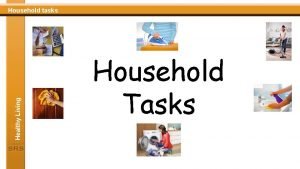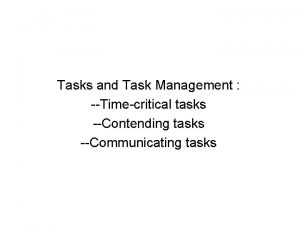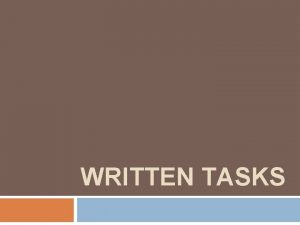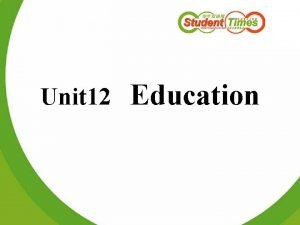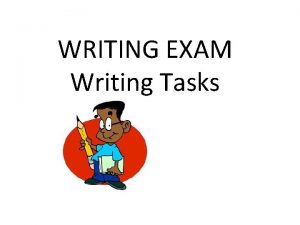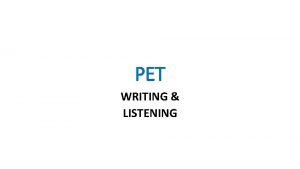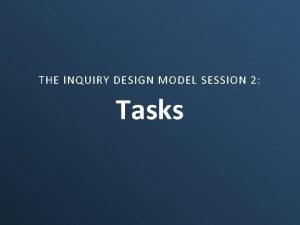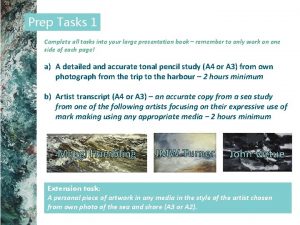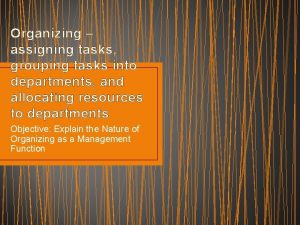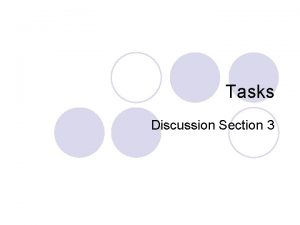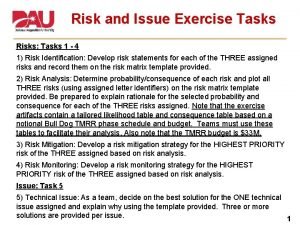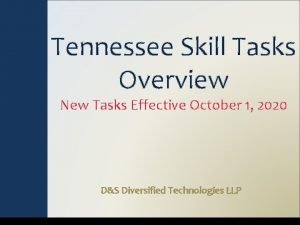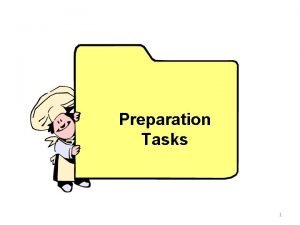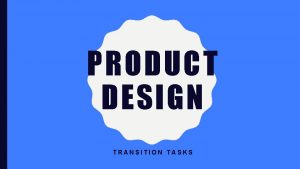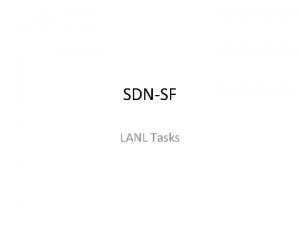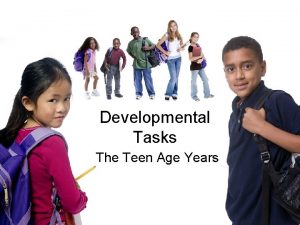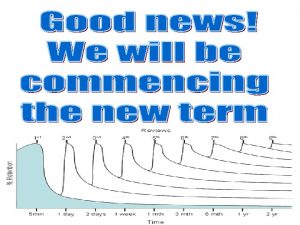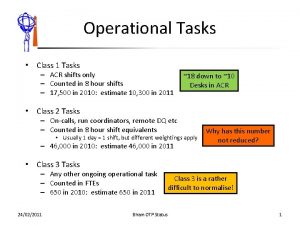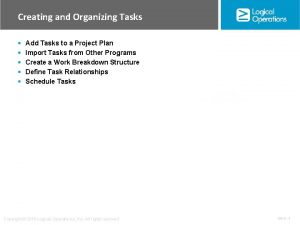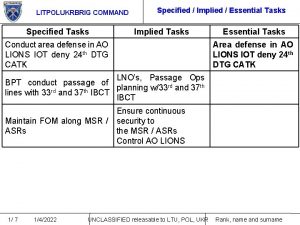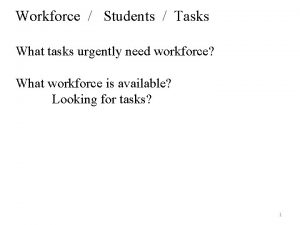Lesson 3 Writing Tasks Writing Tasks on the



























- Slides: 27

Lesson #3: Writing Tasks

Writing Tasks on the OSSLT Writing is the process of communicating your understanding in various forms Through a combination of short- and long-writing tasks, the OSSLT focuses on three writing skills: 1) developing a main idea with sufficient supporting details; 2)organizing information and ideas in a clear manner and 3) using conventions (syntax, spelling, grammar, punctuation) in a manner that does not distract from clear communication. The lined space provided for written work indicates the approximate length of the writing expected.

Types of Writing Questions There are three types of writing questions on the OSSLT: (1) long-writing tasks , (2) multiple-choice questions, and (3) short-writing tasks.

Types of Writing Questions (1) Long-writing tasks There are two long-writing tasks: (i) a news report and (ii) a series of paragraphs expressing an opinion (an essay) We will talk about these in more details later this week.

Types of Writing Questions (2) Multiple Choice Questions The multiple-choice questions for writing deal with writing skills. You will be asked questions about grammar, sentence structure, purpose, etc.

Types of Writing Questions Example #1: Multiple Choice Questions related to writing What do you think the answer is?

Types of Writing Questions Example #1: Multiple Choice Questions related to writing THE ANSWER IS D

Types of Writing Questions Example #2: Multiple Choice Question related to writing What do you think the answer is?

Types of Writing Questions Example #2: Multiple Choice Questions related to writing THE ANSWER IS D

Student Activity #1: Section B: Writing Notice that all these multiple choices questions relate to writing- sentence structure, grammar, organization, etc. Take a few minutes to answers the questions and we will take them up as a class.

Student Activity #1: Section B: Writing (Answers) Handout practice sheet.

Types of Writing Questions Continued (3) Short Writing Tasks These tasks will give students the opportunity to demonstrate their writing skills using their knowledge and personal experience. Responses must be written in complete sentences. Students are given six lines for their response. Try to use all the space provided. If you are not filling in the lines- your answer is likely too brief.

(3) Short Writing Tasks. Written Answers The short written answers come in two types:

(i) Written answers related to a READING- EXAMPLE In some cases you will be asked to provide a written answer related to a READING. You need to read the article to answer this written question.

(ii) Written answers related to WRITING- EXAMPLE In some cases you will be asked to provide a written answer(s) related to a stand alone question. You DON’T need to read anything in order to answer this written question.

Short Writing Tasks- Rubric Teachers please handout the ledger handout with rubric to students. All short writing tasks are marked for: (1)Topic Development /30 AND (2) Use of Conventions /20 Total= /50 marks

Short Writing Tasks- Rubric

Helpful Tips For Written Answers: The S. E. E. S. method Organize your Rough Notes area using the SEES method. Write down SEES vertically and then jot one or two words down for each letter organizing what you want to say. S - Sentence 1 – Statement rewrites the question and gives a clear/specific answer to it. E - Sentence 2 – Explanation / Examples from the text which support your opening statement. (could be more than one sentence) E - Sentence 3 – Explanation / Examples from the text OR your own experiences which support your opening statement. (could be more than one sentence) S - Sentence 4 – Summary statement

Student Activity # 2: Practice Written Answer This question asks you to Summarize the reading selection. Handout practice sheet

Use the Rubric we just discussed to Grade your response. What Grade would you give yourself?

TIP: On the actual test there is a lot of space for Rough Notes. Use it wisely.

Sample Answers to Student Activity #2 The next few examples are scored /30. We are just looking at the topic development part of the rubric. Remember another /20 marks is based on conventions.

Let’s see what a score of 10/30 looks like This response provides a correct main idea only (“It is one of the most visited museums in the world. ”).

Let’s see what a score of 20/30 looks like

Let’s see what a score of 30/30 looks like What Rough Notes might look like for a level 30/30 S – Museum b-day 2006 (line 1, 2) E – Most visited (line 2, 3, 4) E – Website (line 15, 16) S – Summary This student has decided that when they summarized the selection the main idea was all about the number of visitors. This information was all found at the beginning and end of the reading.

Student Activity #3: Section D: Writing Notice that this is a stand alone question. It does not require that you read something before answering. Use the SEES method to plan your response in the rough note area. SEES METHOD REVIEW S - Sentence 1 – Statement rewrites the question and gives a clear/specific answer to it. E - Sentence 2 – Explanation / Examples from the text which support your opening statement. (could be more than one sentence) E - Sentence 3 – Explanation / Examples from the text OR your own experiences which support your opening statement. (could be more than one sentence) S - Sentence 4 – Summary statement Use the rubric to self and peer evaluate your work.

Thank you for your attention and participation! If you would like a copy of this Power. Point you can visit www. enss. ca for all the materials used for each OSSLT preparation lesson. Select the “Literacy” link on the left.
 Hát kết hợp bộ gõ cơ thể
Hát kết hợp bộ gõ cơ thể Ng-html
Ng-html Bổ thể
Bổ thể Tỉ lệ cơ thể trẻ em
Tỉ lệ cơ thể trẻ em Chó sói
Chó sói Glasgow thang điểm
Glasgow thang điểm Alleluia hat len nguoi oi
Alleluia hat len nguoi oi Kể tên các môn thể thao
Kể tên các môn thể thao Thế nào là hệ số cao nhất
Thế nào là hệ số cao nhất Các châu lục và đại dương trên thế giới
Các châu lục và đại dương trên thế giới Công của trọng lực
Công của trọng lực Trời xanh đây là của chúng ta thể thơ
Trời xanh đây là của chúng ta thể thơ Mật thư tọa độ 5x5
Mật thư tọa độ 5x5 Làm thế nào để 102-1=99
Làm thế nào để 102-1=99 Phản ứng thế ankan
Phản ứng thế ankan Các châu lục và đại dương trên thế giới
Các châu lục và đại dương trên thế giới Thơ thất ngôn tứ tuyệt đường luật
Thơ thất ngôn tứ tuyệt đường luật Quá trình desamine hóa có thể tạo ra
Quá trình desamine hóa có thể tạo ra Một số thể thơ truyền thống
Một số thể thơ truyền thống Cái miệng nó xinh thế chỉ nói điều hay thôi
Cái miệng nó xinh thế chỉ nói điều hay thôi Vẽ hình chiếu vuông góc của vật thể sau
Vẽ hình chiếu vuông góc của vật thể sau Thế nào là sự mỏi cơ
Thế nào là sự mỏi cơ đặc điểm cơ thể của người tối cổ
đặc điểm cơ thể của người tối cổ Ví dụ về giọng cùng tên
Ví dụ về giọng cùng tên Vẽ hình chiếu đứng bằng cạnh của vật thể
Vẽ hình chiếu đứng bằng cạnh của vật thể Vẽ hình chiếu vuông góc của vật thể sau
Vẽ hình chiếu vuông góc của vật thể sau Thẻ vin
Thẻ vin đại từ thay thế
đại từ thay thế




























